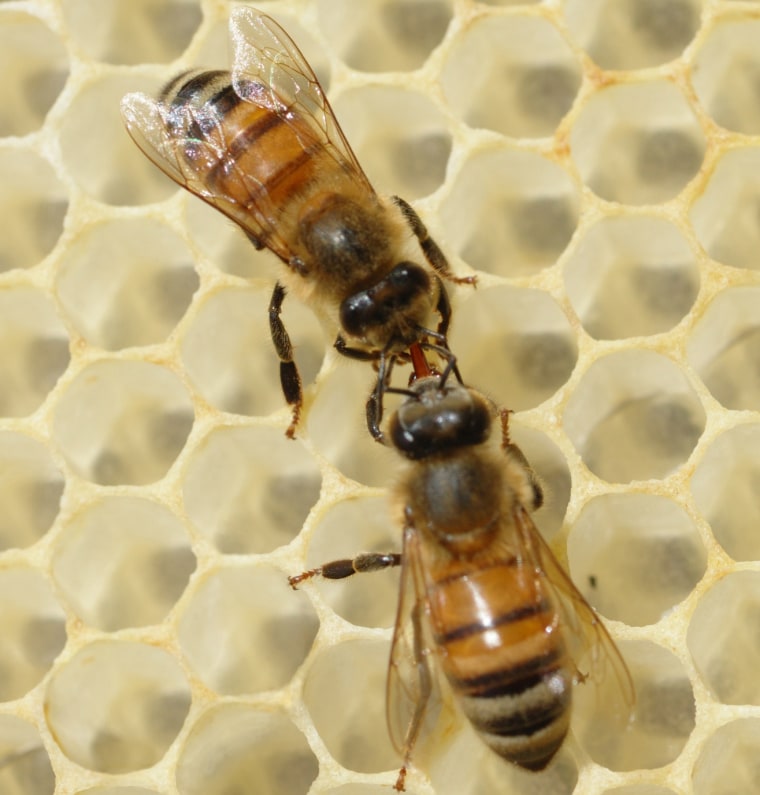Within their buzzing societies, some honeybees are more likely to take risks than others, and according to a new study, these novelty-seeking bees have genetic similarities with people who are drawn to adventure.
The study, which is the first to dissect the molecular basis of risk-taking behavior in bees, might eventually aid in honeybee conservation.
On a deeper level, the results suggest that at least part of what we call “personality” can be traced back to deeply ancient roots, offering yet more evidence that we share far more in common with distantly related creatures than many people are comfortable accepting.
“You look at animals and they look really different and they act really different, but when you drill down deeper and look at the genomics, you find these deep commonalities,” said Gene Robinson, an entomologist, geneticist and neuroscientist at the University of Illinois at Urbana-Champaign. “When you see this kind of result, you can say that personality is not a human invention.”
Among the many fascinating features of honeybee social structure, some members of the hive act as food scouts. Contrary to how models predict animals should behave, these scouts — which make up between 5 and 25 percent of bees in a hive — don’t return again and again to good sources of food. Instead, they tell their friends about an excellent bunch of flowers. Then, they strike off into the great and dangerous unknown in search of new, yet still undiscovered flower patches.
To find out what drives that kind of risk-taking behavior in honeybees, Robinson and colleagues started by using an experiment to classify as scouts those bees that were driven to seek out newly introduced feeders. The majority of bees played it safe and chose to stick with the feeder they were trained on.
Next, the researchers analyzed and compared the genes of both groups of bees, which revealed more than 1,000 genetic differences between risk-taking scouts and their more conservative peers. What’s more, the team reports in Friday's issue of the journal Science, the genes and neurochemical pathways involved showed many parallels with the genes and pathways that are known to influence risk-taking behavior in mammals, including people.
In another line of tantalizing research, scientists have linked so-called thrill-seeking genes in people with a greater propensity for a wide range of behaviors, including alcohol and gambling addictions, promiscuity, skydiving and even an affinity for Wall Street stock trading. Among other brain chemicals, the feel-good neurotransmitter dopamine plays a role, giving novelty-prone people a rewarding feeling when they do something new. Robinson and colleagues used information about the genetics of thrill seeking in mammals and people to guide their search for genes that might affect analogous behavior in bees.
When the scientists experimentally manipulated genes implicated in risk-taking by turning their expression up or down, they were able to increase or decrease the probability that individual bees would become food scouts. That allowed the team to draw a direct link between particular genes and novelty-seeking behavior.
QUIZ: How much do you know about bees?
In order to qualify as what we think of as personality traits, certain kinds of behaviors have to apply in different contexts. The researchers were able to demonstrate this kind of consistency in honeybees by showing experimentally that food-scouting bees were more than three times as likely to also scout out new nest sites compared to less adventurous bees.
Honeybees pollinate about a third of all of the food crops we eat, so understanding what influences bee behavior and how bees make decisions could someday become key information for efforts to protect and conserve the insects.
And while bees certainly don’t have complex and nuanced personalities like people do, the new research offers a long view of how certain behaviors may have come to be so widespread throughout the animal kingdom, said Hans Hofmann, a behavioral genomicist at the University of Texas at Austin.
“I’m not going to tell you this is going to cure disease or give us more honey — I’m not going to rule that out, but that wouldn’t come from this as an immediate consequence,” Hofmann said, adding that the pathways that influence novelty seeking now appear to date back to at least the time when honeybees and humans shared a common ancestor.
“We like to think we’re different and better than everything else,” he added. “I think this tells us more about ourselves in terms of where we come from on a more philosophical level. This tells us more about ourselves.”
